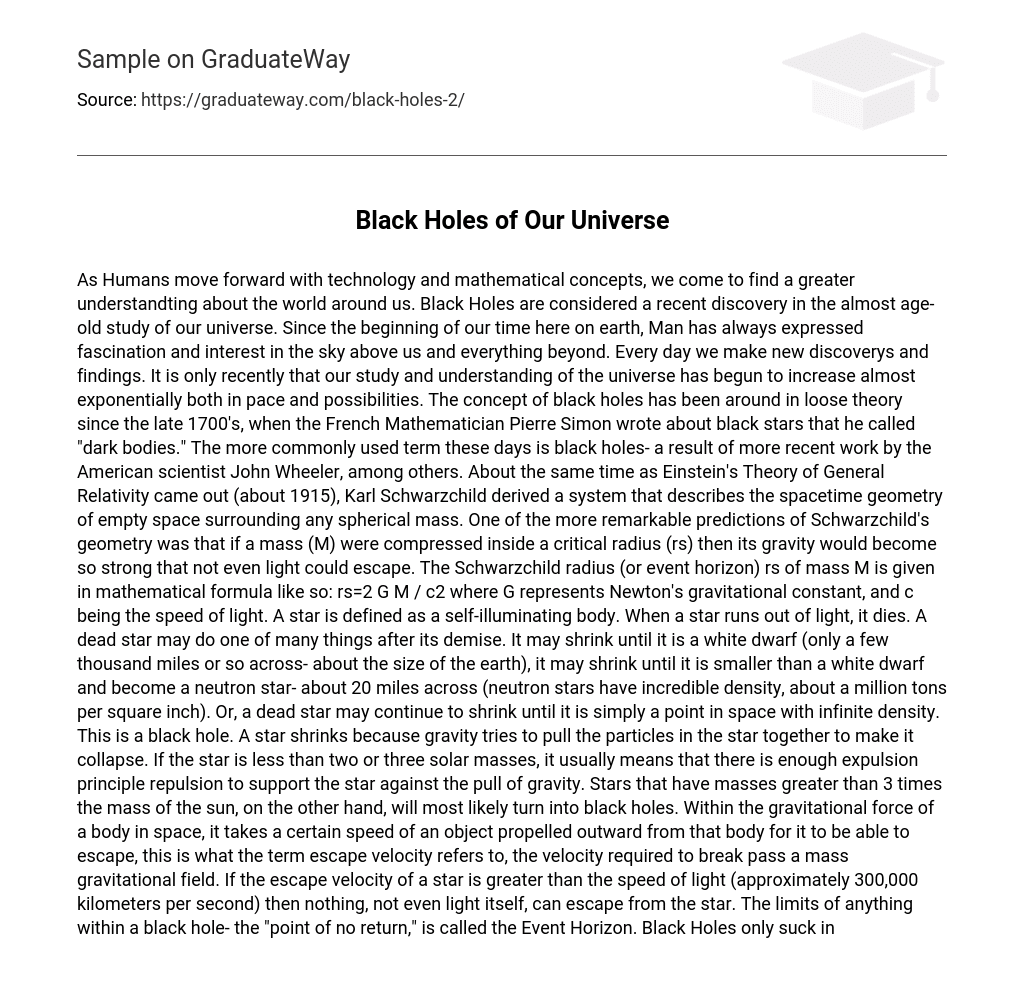As Humans move forward with technology and mathematical concepts, we come to find a greater understandting about the world around us. Black Holes are considered a recent discovery in the almost age-old study of our universe.
Since the beginning of our time here on earth, Man has always expressed fascination and interest in the sky above us and everything beyond. Every day we make new discoverys and findings. It is only recently that our study and understanding of the universe has begun to increase almost exponentially both in pace and possibilities. The concept of black holes has been around in loose theory since the late 1700’s, when the French Mathematician Pierre Simon wrote about black stars that he called “dark bodies.” The more commonly used term these days is black holes- a result of more recent work by the American scientist John Wheeler, among others. About the same time as Einstein’s Theory of General Relativity came out (about 1915), Karl Schwarzchild derived a system that describes the spacetime geometry of empty space surrounding any spherical mass.
One of the more remarkable predictions of Schwarzchild’s geometry was that if a mass (M) were compressed inside a critical radius (rs) then its gravity would become so strong that not even light could escape. The Schwarzchild radius (or event horizon) rs of mass M is given in mathematical formula like so: rs=2 G M / c2 where G represents Newton’s gravitational constant, and c being the speed of light. A star is defined as a self-illuminating body. When a star runs out of light, it dies.
A dead star may do one of many things after its demise. It may shrink until it is a white dwarf (only a few thousand miles or so across- about the size of the earth), it may shrink until it is smaller than a white dwarf and become a neutron star- about 20 miles across (neutron stars have incredible density, about a million tons per square inch). Or, a dead star may continue to shrink until it is simply a point in space with infinite density. This is a black hole. A star shrinks because gravity tries to pull the particles in the star together to make it collapse. If the star is less than two or three solar masses, it usually means that there is enough expulsion principle repulsion to support the star against the pull of gravity.
Stars that have masses greater than 3 times the mass of the sun, on the other hand, will most likely turn into black holes. Within the gravitational force of a body in space, it takes a certain speed of an object propelled outward from that body for it to be able to escape, this is what the term escape velocity refers to, the velocity required to break pass a mass gravitational field. If the escape velocity of a star is greater than the speed of light (approximately 300,000 kilometers per second) then nothing, not even light itself, can escape from the star. The limits of anything within a black hole- the “point of no return,” is called the Event Horizon. Black Holes only suck in everything within this certain distance from its center.
Anything outside this horizon would, however, be perfectly safe and could orbit the black hole quite successfully without fear of being sucked in. Aside from the event horizon, the other major feature of a black hole is in the center. It is the point of singularity. Singularity is a point where all the known and understood laws of nature cease to exist. Scientists believe that black holes do strange things to the time and space around them.
Outside of a black hole the warping of space causes time itself to slow down. If you were to watch a clock fall in to a black hole, the passing of seconds on that clock would slow down as it fell until it passes the event horizon, where you would essentially see time stop. If, however, a person fell into a black hole, they would not notice any passing of time because literally everything slows down within this area- the person’s breathing, thoughts, perception. The person would fall until they reached the point of singularity- where they would explode because of the density. Gravity is a constant force throughout our universe.
All objects in space have gravity. While we tend to think of gravity as being a force that attracts or pulls inwards, the actual implications of gravity are a little different. Gravity directly depends on the mass of a body in space. The effect of gravity on space is that it becomes curved.
The stronger the gravity, the stronger the warping of the space surrounding it. Until the mid-nineties, there was no actual proof of black holes. Yet the theories surrounding them were so strong that most scientists did not need physical proof to believe in what their equations and formulas told them. When the first real proof of black holes was uncovered, it was seen more as a validation of long held beliefs than as a groundbreaking new discovery.
Although different sources quoted different exact dates, it appears that the first proof came in 1992 when NASA’s Hubbell Space Telescope brought home the fist picture of one. The picture was not actually of a black hole, but rather it was an image of a giant disc of cold gas and dust, which scientists believe fuel a black hole. It seems that with all this information on black holes, we should understand them with clarity. And yet, full comprehension of black holes is still not known to us, as has much other knowledge concerning the vastness of time and space. The possibilities that come with black holes and the relevant theoretical implications are inspiring.
They bring us a little closer to understanding the makeup of our universe,





